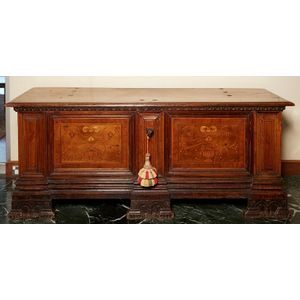Arts & Crafts Walnut Sideboard with Original Features
You must be a subscriber, and be logged in to view price and dealer details.
Subscribe Now to view actual auction price for this item
When you subscribe, you have the option of setting the currency in which to display prices to $Au, $US, $NZ or Stg.
- Hardware - A general term applied to the metal fittings on an item of furniture, such as locks, hinges and handles. Whilst most furniture will usually have brass hardware as it does not rust, some earlier rustic objects such as coffers sometimes have iron hardware.
- Pad Foot - In furniture design, a pad foot refers to a type of
furniture foot that is shaped like a flattened ball or pad. It is a common
design element in traditional furniture styles, particularly in English and
American furniture from the 18th and 19th centuries. The pad foot is typically
wider than it is tall, with a broad, flat surface that rests directly on the
floor. It is often carved or turned with decorative details, such as fluting or
ridges, and can be made from a variety of materials, such as wood, metal, or
leather.
Pad feet are used to support the legs of various types of
furniture, such as chairs, tables, and cabinets. They are often used in
combination with other types of feet, such as bun feet or bracket feet, to
create a more complex and decorative furniture design. In terms of
functionality, pad feet provide stability and support to furniture pieces, and
can help distribute the weight of the piece evenly across the floor. In terms
of design, they add a classic and traditional look to furniture designs, and
are often used to create a sense of elegance and refinement. - Bevel / Chamfer - In furniture making, a chamfered corner refers to a technique used to create a smooth, angled edge on the corner of a piece of furniture. This is typically done by cutting away a small portion of the corner at an angle, typically 45 degrees, creating a diagonal edge, rather than a sharp 90-degree angle. This technique can be used on various parts of a piece of furniture such as table legs, drawer fronts, or door frames. Chamfering can add visual interest to a piece and can help to soften the overall look of a piece of furniture. It is often used in conjunction with other techniques, such as rounding edges or using contrasting wood species to create a more elegant, sophisticated look. Chamfering is a simple way to add a touch of elegance to a piece of furniture and it is a common technique used by furniture makers.
This item has been included into following indexes:
Visually similar items

An Italian walnut cassone, 17th century, with vase and scrolling tulip inlay panels on Baroque moulded block feet, 172 width x 55 depth x 68.5 cm height

Antique French Louis XVI style walnut buffet. 150 cm wide, 250 cm high

Antique French Renaissance style walnut six door buffet, carved in high relief with a hunting party on horse back

A large vintage oak mirror back sideboard, the base with ornate carved decoration and central open shelf, two panelled cupboard doors and four drawers, the top section with open shelf on four turned column supports and central oblong mirror. Good colour an
